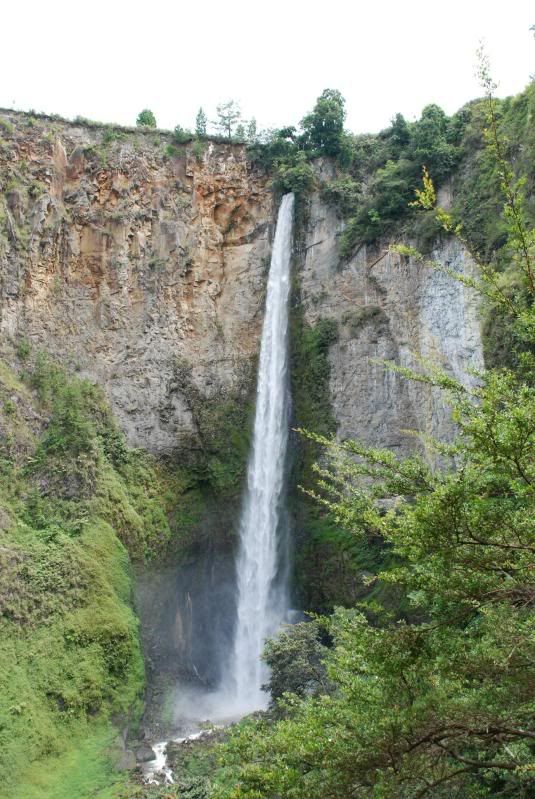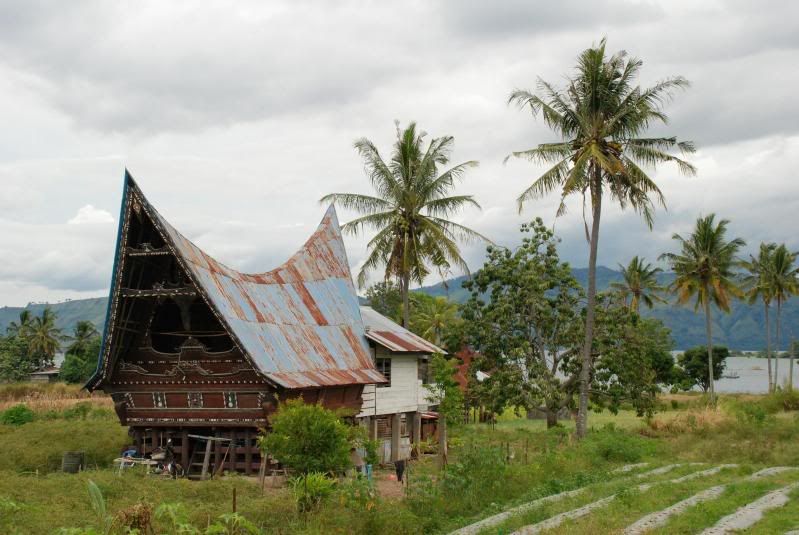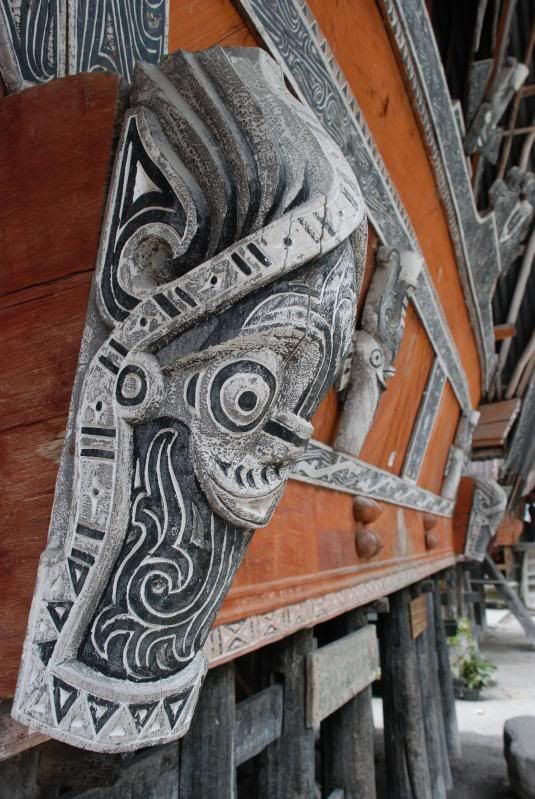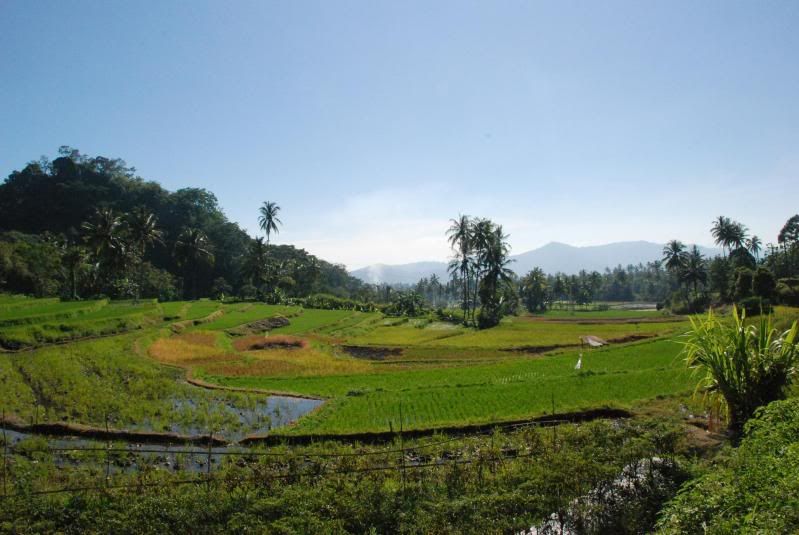I left Singapore feeling hugely better, but without having done much apart from spend money like it was going out of fashion. Apart from a new camera lens, one thing I did have was a two month Indonesian visa, which was a huge bonus as the queue for visas at Denpasar airport, Bali, was hours long.
I stopped in Bali for a night before picking up a flight the next day; it was just long enough to be ripped off by a taxi from the airport (almost impossible to escape this) and to stay in Seminyak, a "hip" part of Bali north of the fabled tourist nightspot of Kuta - that was where the bombs exploded in 2002. Seminyak had a grey beach filled with tourists, hawkers and masseuses, but it was possible to find a little warung and eat cheaply whilst watching the world go by. It wasn't set up well for the solo traveller, so after an early night I boarded a small flight westwards to Labaun Bajo, on the island of Flores to the east.
From Bali, the chain of islands that stretches east goes Lombok - Sumbawa- Flores - Sumba - Timor and is called the Nusa Tenggara; I didn't have time to go as far east as I wanted (preferably East Timor) but settled on Flores, from where in Labuan Bajo it is possible to visit the islands of Komodo and Rinca with their famous dragons, as well as dive in some of the most pristine waters in the world. I also wanted to head to eastern Flores, along the tiny road that winds it's way tortuously along Flores' mountainous spine.
The reputation of Indonesia's multitude of domestic airlines is not great - Indonesian airlines are banned from European airspace due to certain safety issues. My TransNusa flight, however, was perfectly acceptable - the food was even edible. I was relieved not to have been allocated one of the seat rows that was sitting on the runway rather than in the plane though....
In Labuan Bajo I hooked up with an Australian called Matt who had come along for the diving, and after establishing that I was unable to get a group together to hire a car, booked in for 3 days of diving with DiveKomodo, one of several local operators. Last year another place in town - a PADI 5 star centre no less - made international headlines when it "lost" a group of divers who had drifted a long distance in an exceptionally strong current. The divers were found alive and well after a couple of days, but I made a note not to go with that company, something Matt and I were pleased about the following day when their boat broke down.
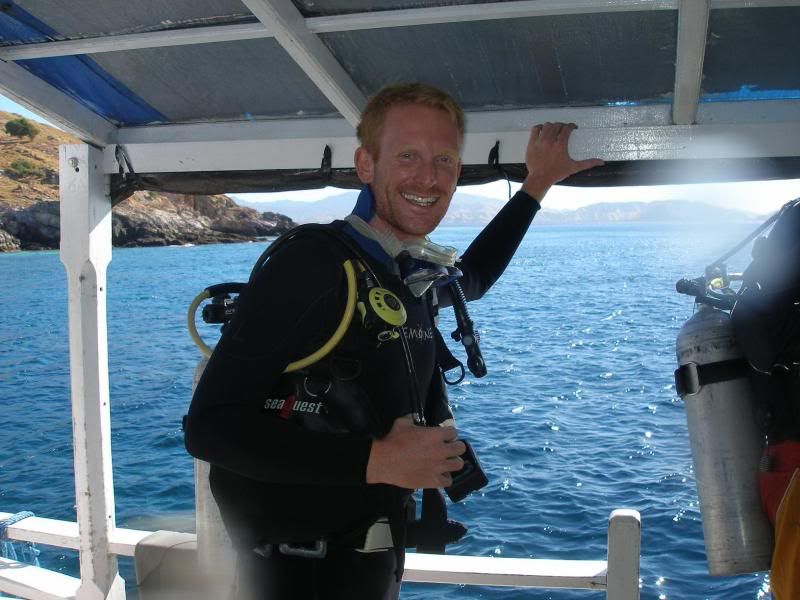

Despite a little bit of sea sickness the first day, the diving was all it was cracked up to be. On two days I saw manta rays - huge animals several metres across - and plenty of sharks and turtles, but it was the variety and quality of coral and fish that really blew my mind. The currents were also something else, far stronger than anything else I had experienced. At one point we emerged from a canyon next to a group of giant trevally and bumphead parrot fish in an incredibly strong current. Matt and I clung on next to our dive master to get a lbetter ook at them - my mask began to be pulled off my face when I turned my face out of the current. Letting go of the rocks was a little like what I imagine jumping out of a plane would be - very fast and pretty exciting!

This colourful thing is a nudibranch. They are REALLY cool.
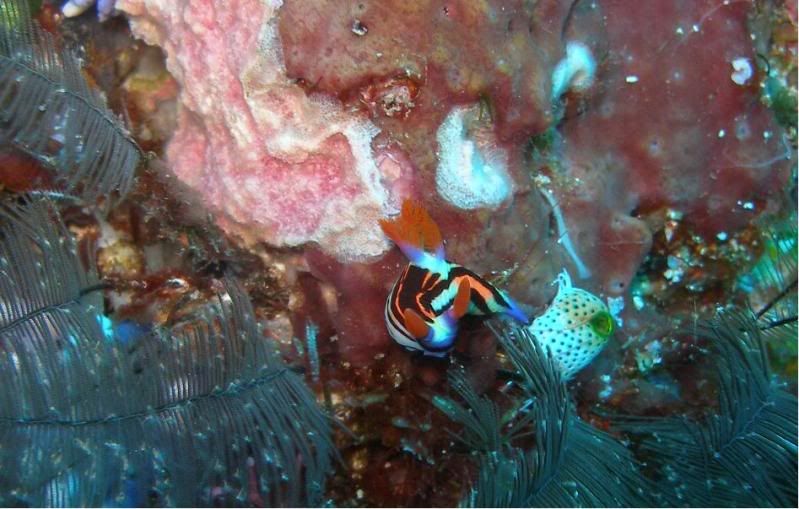
The other people on the dive boat were all nice and in the evenings we would head up to the local sundowner bar, where a live band would be playing whilst the cold beers and inescapable banana pancakes were being served. The local restaurants all served a variety of excellent fish dishes, and it was also our debatable luck to be in town when the "Labuan Bajo Idol" contest was being held - either the locals didn't usually applaud after each performance, or else they really thought the songs were as bad as we did.


On the last day we also made a quick side trip to Rinca to see the area's most famous occupants - Komodo dragons. In reality the dragons are just another species of monitor lizard, albeit the biggest in the world and ones that eat people with alarming regularity. The dragons tend to kill their prey by waiting near waterholes then biting their victims - the dragons' mouths are full of bacteria and the prey dies a week or two later from the infection.



At this point I began to run...
As well as the dragons, Rinca is home to waterbuffalo, wild boar, deer and a variety of venomous snakes. Usually people see at least one of them; we were lucky to spot a waterbuffalo and deer, and then our guide almost trod on a spitting cobra. It was not a happy bunny - although this didn't stop us getting stupidly close.

Somehow after my third day of diving I managed to find a couple of Portuguese doctors on their way to East Timor and another English girl, Hannah, and we departed eastwards in a hired car the following morning. It promised to be a long day, even though it was only 250km or so to our destination of Bajawa that evening. The road on the whole was not too bad, but the neverending bends and hill climbs, plus the occasional stretch of vast potholes took it's toll on both the car and our rear ends.
The interior of Flores is dominated by a range of mountains that runs east to west, and makes any attempt at road building fraught with difficulty, especially when you're in Indonesia and it has to be done with improbably small tools and a cigarette in one hand. The scenery was beautiful, dominated by endless rice paddies and small villages. The rice harvest was about due, so the usual verdant green was replaced by larger yellowing plants in paddies that had often been drained.

Kids in Ruteng, en route to Bajawa
Arrival in Bajawa that evening was cold, relatively speaking, and the fleeces and long sleeves were broken out from their hibernation at the bottom of my bag. After a delicious meal and some remarkably good live music - I've never heard Indonesians singing in Spanish before, but it was excellent - we decided that, as a group, we lacked musical talent but liked singing along anyway.
The next day we continued on the seemingly marathon journey, stopped first in the village of Buka - a traditional village full of animist culture and thatched houses, that is being desperately preserved in order to draw in the scanty flow of tourists in these parts. The village was pretty, and the people very friendly; we turned down the offers of both the traditional weavings available and the chicken sacrifice (that would have cost extra). Our driver, Jamie, deserved a mention for being probably the safest driver in Indonesia, rarely exceeding 40km/h and liberal using the horn to warn off pigs, goats and small children.

After getting to the southern coast of Flores with it's black sand volcanic beaches, we stopped in the port of Ende for lunch and pushed on, driving uphill for the next few hours to reach Moni, our final destination from where we would visit Kelimutu, volcano of the fabled Three Different Coloured Lakes (I guess it's more of a local fable than one of international renown). We checked into a friendly guesthouse and after a distinctly below-par meal, trekked through some muddy rice paddies in the pitch dark to find our way to some hot springs - they were well worth the mud and stubbed toes.

The following morning we were gone by 4.30am for the highlight of our trip, sunrise over Kelimutu. The volcano, which hasn't been active for some years, has three small crater lakes which change colour every few years - currently they are light green, dark green and black, but in the past have ranged from red to brown and blue. It was cold - colder than Bajawa a couple of nights before - and we were thankful of the enterprising locals who trekked up with us to offer expensive cups of tea and coffee (as well as the usual "local" weavings). I felt myself getting a cold, along with the rest of the guys in the car.


The sunrise was all it was cracked up to be, and well worth the effort of the journey and the early morning. Just before hypothermia set in the sun rose above the horizon and took the edge of the biting wind, whilst the lakes gradually shone into view. It was lovely.
After heading back to the hotel for breakfast, we went back to Ende to leave the Portuguese girls to their East Timor mission - some kind of NGO doctoring work. Jamie was keen to press back to Labuan Bajo that day - a 16 hour drive - so after negotiating we managed to settle on a stop in Bajawa again that night, and Hannah and I relaxed in the 4x4 as Jamie cruised back along the winding roads. The day passed surprisingly quickly - I slept a lot - but was awake when we nearly ran over a toddler who ran out into the road in front of the car without a care in the world - it was a very close shave.
In Bajawa we picked up a couple of quiet English lads for the ride back, and made good time back to Labuan Bajo the following day - stopping only to change a set of obliterated brake pads (they were molten in places) that Jamie had already replaced at the start of the journey. I booked into a quiet bungalow and set about trying to rid myself of the cold, sort out more diving and a ticket out of Flores.

After two days of rest, laundry and reading, I was feeling well enough to descend to the depths again and go diving once more. I went with DiveKomodo again, principally because I could hire my dive master's camera, and tried to record what I was seeing - with limited success! I may get to putting a few videos on YouTube if I ever find a connection fast enough. It was another great day - 3 dives this time - but disappointingly I failed to see any more manta rays. That evening I was around when one of the dive masters found an injured kitten and brought it to me - there's nothing like bumping off a kitten to bring a bad end to a good day.




The morning after I left Labuan Bajo on a cruise to Lombok. My original plan of flying back had been scuppered by overbooked flights, and my fall-back plan of taking an overnight boat failed too. My last option (and I drew the line at the 40 hour ferry-bus-ferry combo across Sumbawa) was to take a 4 day trip past Rinca, Komodo and northern Sumbawa to get to Lombok. The journey was made much easier by the presence of Francisco and Michela, an Italian couple who I had met at Kelimutu and were on their 9 month honeymoon. They were on possibly the world's longest visa run - they had hired a moped in Bali and were driving to East Timor and back, a mammoth undertaking that seemed harebrained to say the least. They were great. At the last minute our little cruise was joined by Sebastian, Isa and Shimon, a Polish-English couple and their Polish friend, and our little group of 6 left port on a surprisingly seaworthy looking boat.



The first day we stopped at Rinca, the second at Komodo..... in all we mader a lot of stops at various deserted beaches and interesting sites, but for me the best bit was just sitting on the foredeck and watching the sun go down each night, as we gently chugged our way westwards. It was fantastic. We stopped on day 3 at a freshwater point in north Sumbawa and that was great - walking upriver to a little waterfall where we could wash and get the salt off ourselves. I was a little sad on the morning of day 4 when we steamed into Labuan Lombok, although banana fritters for breakfast were definitely beginning to wear a little thin.


In case you're wondering, that is actually something's guts hanging out of the dragon's mouth...



Together with Sebastian and co, we hired a car to take us across Lombok where I was heading to Sengiggi and the next leg of my trip. Believe it or not, I now have a plan that takes me right up to arriving in Australia on 20th October (one days before my visa would run out), and includes a visit to New Zealand to see my sister and Fran before they head off again. But for now, I'm heading eastwards to Java.....
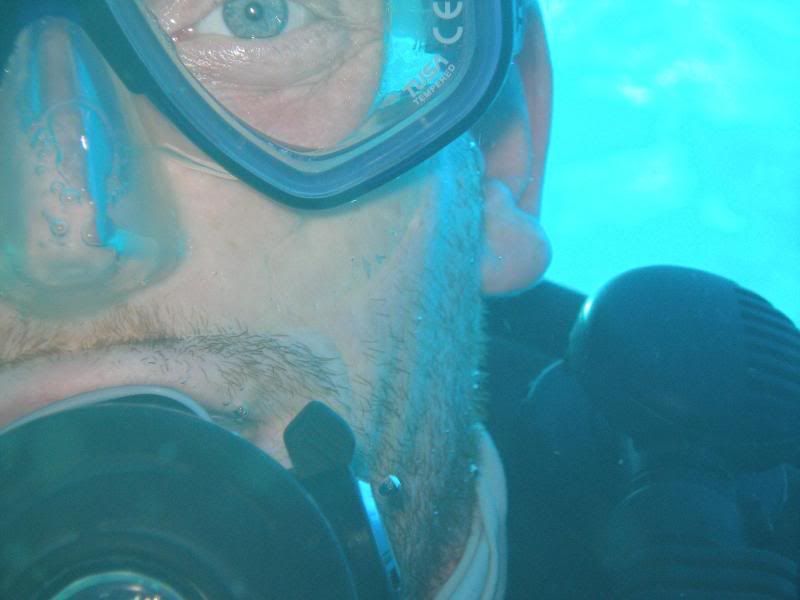
I stopped in Bali for a night before picking up a flight the next day; it was just long enough to be ripped off by a taxi from the airport (almost impossible to escape this) and to stay in Seminyak, a "hip" part of Bali north of the fabled tourist nightspot of Kuta - that was where the bombs exploded in 2002. Seminyak had a grey beach filled with tourists, hawkers and masseuses, but it was possible to find a little warung and eat cheaply whilst watching the world go by. It wasn't set up well for the solo traveller, so after an early night I boarded a small flight westwards to Labaun Bajo, on the island of Flores to the east.
From Bali, the chain of islands that stretches east goes Lombok - Sumbawa- Flores - Sumba - Timor and is called the Nusa Tenggara; I didn't have time to go as far east as I wanted (preferably East Timor) but settled on Flores, from where in Labuan Bajo it is possible to visit the islands of Komodo and Rinca with their famous dragons, as well as dive in some of the most pristine waters in the world. I also wanted to head to eastern Flores, along the tiny road that winds it's way tortuously along Flores' mountainous spine.
The reputation of Indonesia's multitude of domestic airlines is not great - Indonesian airlines are banned from European airspace due to certain safety issues. My TransNusa flight, however, was perfectly acceptable - the food was even edible. I was relieved not to have been allocated one of the seat rows that was sitting on the runway rather than in the plane though....
In Labuan Bajo I hooked up with an Australian called Matt who had come along for the diving, and after establishing that I was unable to get a group together to hire a car, booked in for 3 days of diving with DiveKomodo, one of several local operators. Last year another place in town - a PADI 5 star centre no less - made international headlines when it "lost" a group of divers who had drifted a long distance in an exceptionally strong current. The divers were found alive and well after a couple of days, but I made a note not to go with that company, something Matt and I were pleased about the following day when their boat broke down.


Despite a little bit of sea sickness the first day, the diving was all it was cracked up to be. On two days I saw manta rays - huge animals several metres across - and plenty of sharks and turtles, but it was the variety and quality of coral and fish that really blew my mind. The currents were also something else, far stronger than anything else I had experienced. At one point we emerged from a canyon next to a group of giant trevally and bumphead parrot fish in an incredibly strong current. Matt and I clung on next to our dive master to get a lbetter ook at them - my mask began to be pulled off my face when I turned my face out of the current. Letting go of the rocks was a little like what I imagine jumping out of a plane would be - very fast and pretty exciting!

This colourful thing is a nudibranch. They are REALLY cool.

The other people on the dive boat were all nice and in the evenings we would head up to the local sundowner bar, where a live band would be playing whilst the cold beers and inescapable banana pancakes were being served. The local restaurants all served a variety of excellent fish dishes, and it was also our debatable luck to be in town when the "Labuan Bajo Idol" contest was being held - either the locals didn't usually applaud after each performance, or else they really thought the songs were as bad as we did.


On the last day we also made a quick side trip to Rinca to see the area's most famous occupants - Komodo dragons. In reality the dragons are just another species of monitor lizard, albeit the biggest in the world and ones that eat people with alarming regularity. The dragons tend to kill their prey by waiting near waterholes then biting their victims - the dragons' mouths are full of bacteria and the prey dies a week or two later from the infection.



At this point I began to run...
As well as the dragons, Rinca is home to waterbuffalo, wild boar, deer and a variety of venomous snakes. Usually people see at least one of them; we were lucky to spot a waterbuffalo and deer, and then our guide almost trod on a spitting cobra. It was not a happy bunny - although this didn't stop us getting stupidly close.

Somehow after my third day of diving I managed to find a couple of Portuguese doctors on their way to East Timor and another English girl, Hannah, and we departed eastwards in a hired car the following morning. It promised to be a long day, even though it was only 250km or so to our destination of Bajawa that evening. The road on the whole was not too bad, but the neverending bends and hill climbs, plus the occasional stretch of vast potholes took it's toll on both the car and our rear ends.
The interior of Flores is dominated by a range of mountains that runs east to west, and makes any attempt at road building fraught with difficulty, especially when you're in Indonesia and it has to be done with improbably small tools and a cigarette in one hand. The scenery was beautiful, dominated by endless rice paddies and small villages. The rice harvest was about due, so the usual verdant green was replaced by larger yellowing plants in paddies that had often been drained.

Kids in Ruteng, en route to Bajawa
Arrival in Bajawa that evening was cold, relatively speaking, and the fleeces and long sleeves were broken out from their hibernation at the bottom of my bag. After a delicious meal and some remarkably good live music - I've never heard Indonesians singing in Spanish before, but it was excellent - we decided that, as a group, we lacked musical talent but liked singing along anyway.
The next day we continued on the seemingly marathon journey, stopped first in the village of Buka - a traditional village full of animist culture and thatched houses, that is being desperately preserved in order to draw in the scanty flow of tourists in these parts. The village was pretty, and the people very friendly; we turned down the offers of both the traditional weavings available and the chicken sacrifice (that would have cost extra). Our driver, Jamie, deserved a mention for being probably the safest driver in Indonesia, rarely exceeding 40km/h and liberal using the horn to warn off pigs, goats and small children.

After getting to the southern coast of Flores with it's black sand volcanic beaches, we stopped in the port of Ende for lunch and pushed on, driving uphill for the next few hours to reach Moni, our final destination from where we would visit Kelimutu, volcano of the fabled Three Different Coloured Lakes (I guess it's more of a local fable than one of international renown). We checked into a friendly guesthouse and after a distinctly below-par meal, trekked through some muddy rice paddies in the pitch dark to find our way to some hot springs - they were well worth the mud and stubbed toes.

The following morning we were gone by 4.30am for the highlight of our trip, sunrise over Kelimutu. The volcano, which hasn't been active for some years, has three small crater lakes which change colour every few years - currently they are light green, dark green and black, but in the past have ranged from red to brown and blue. It was cold - colder than Bajawa a couple of nights before - and we were thankful of the enterprising locals who trekked up with us to offer expensive cups of tea and coffee (as well as the usual "local" weavings). I felt myself getting a cold, along with the rest of the guys in the car.


The sunrise was all it was cracked up to be, and well worth the effort of the journey and the early morning. Just before hypothermia set in the sun rose above the horizon and took the edge of the biting wind, whilst the lakes gradually shone into view. It was lovely.
After heading back to the hotel for breakfast, we went back to Ende to leave the Portuguese girls to their East Timor mission - some kind of NGO doctoring work. Jamie was keen to press back to Labuan Bajo that day - a 16 hour drive - so after negotiating we managed to settle on a stop in Bajawa again that night, and Hannah and I relaxed in the 4x4 as Jamie cruised back along the winding roads. The day passed surprisingly quickly - I slept a lot - but was awake when we nearly ran over a toddler who ran out into the road in front of the car without a care in the world - it was a very close shave.
In Bajawa we picked up a couple of quiet English lads for the ride back, and made good time back to Labuan Bajo the following day - stopping only to change a set of obliterated brake pads (they were molten in places) that Jamie had already replaced at the start of the journey. I booked into a quiet bungalow and set about trying to rid myself of the cold, sort out more diving and a ticket out of Flores.

After two days of rest, laundry and reading, I was feeling well enough to descend to the depths again and go diving once more. I went with DiveKomodo again, principally because I could hire my dive master's camera, and tried to record what I was seeing - with limited success! I may get to putting a few videos on YouTube if I ever find a connection fast enough. It was another great day - 3 dives this time - but disappointingly I failed to see any more manta rays. That evening I was around when one of the dive masters found an injured kitten and brought it to me - there's nothing like bumping off a kitten to bring a bad end to a good day.




The morning after I left Labuan Bajo on a cruise to Lombok. My original plan of flying back had been scuppered by overbooked flights, and my fall-back plan of taking an overnight boat failed too. My last option (and I drew the line at the 40 hour ferry-bus-ferry combo across Sumbawa) was to take a 4 day trip past Rinca, Komodo and northern Sumbawa to get to Lombok. The journey was made much easier by the presence of Francisco and Michela, an Italian couple who I had met at Kelimutu and were on their 9 month honeymoon. They were on possibly the world's longest visa run - they had hired a moped in Bali and were driving to East Timor and back, a mammoth undertaking that seemed harebrained to say the least. They were great. At the last minute our little cruise was joined by Sebastian, Isa and Shimon, a Polish-English couple and their Polish friend, and our little group of 6 left port on a surprisingly seaworthy looking boat.



The first day we stopped at Rinca, the second at Komodo..... in all we mader a lot of stops at various deserted beaches and interesting sites, but for me the best bit was just sitting on the foredeck and watching the sun go down each night, as we gently chugged our way westwards. It was fantastic. We stopped on day 3 at a freshwater point in north Sumbawa and that was great - walking upriver to a little waterfall where we could wash and get the salt off ourselves. I was a little sad on the morning of day 4 when we steamed into Labuan Lombok, although banana fritters for breakfast were definitely beginning to wear a little thin.


In case you're wondering, that is actually something's guts hanging out of the dragon's mouth...



Together with Sebastian and co, we hired a car to take us across Lombok where I was heading to Sengiggi and the next leg of my trip. Believe it or not, I now have a plan that takes me right up to arriving in Australia on 20th October (one days before my visa would run out), and includes a visit to New Zealand to see my sister and Fran before they head off again. But for now, I'm heading eastwards to Java.....



